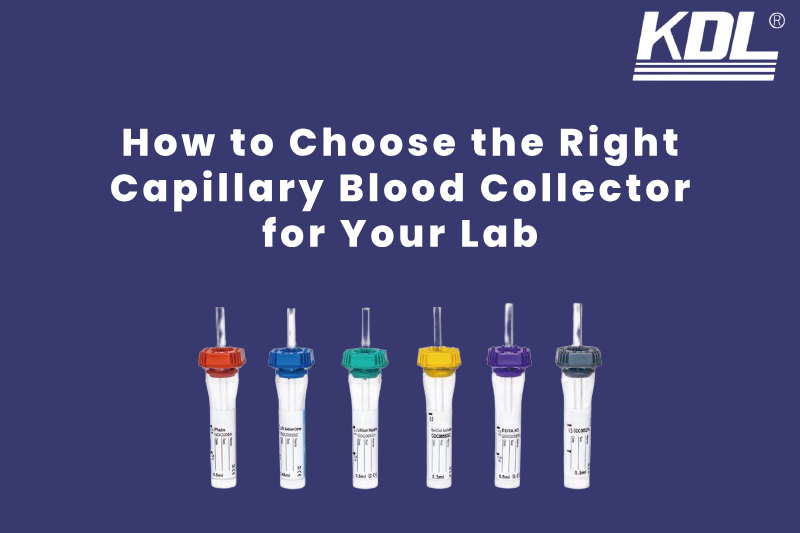
If you work in a lab, clinic, or hospital, you’ve likely used capillary blood collector -drawing small amounts of blood from the fingertip or heel. It’s quick, less invasive than a standard blood draw, and useful for many common tests. Whether you’re working with newborns, older adults, or just need a small blood sample, capillary blood sampling devices can make the job easier and more comfortable for patients.
But choosing the right capillary blood collector isn’t always simple. There are many options, and the one you pick can affect the quality of the sample, how fast the test is done, and even how safe the process is for your staff.
This guide will help you understand your options and choose the best capillary blood collection tools for your lab’s needs.
What Is a Capillary Blood Collector?
A capillary blood collector is a small device used to gather blood from a finger, heel, or other small area with a simple prick. These are commonly used when only a small amount of blood is needed – such as in tests for blood sugar, hemoglobin, or basic blood counts. These collectors are ideal for babies, older adults, or people who need frequent tests.
Why Choosing the Right Capillary Blood Collector Matters
Using the right capillary blood collector helps you get better results and saves time. If the tool doesn’t match the job, it can cause problems like:
- Bad samples: Too much air or not enough blood can mess up test results.
- Wasted time: If you have to collect the sample again, you fall behind.
- Safety concerns: Poor designs can lead to spills or injuries.
- Unhappy patients: Especially when working with babies or older adults, comfort matters.
Choosing the right capillary blood collection supplies means fewer problems and smoother operations in your lab.
Types of Capillary Blood Collector
There are a few main types of capillary blood collectors, each designed for specific tasks. Knowing the difference helps you pick the right one for your lab.
1. Microtainer Tubes
These are micro blood tubes use to collect and store blood. Many come with colored caps to show which type of test they’re for-like purple for blood counts or green for chemistry tests. They’re easy to hold, often marked with volume lines, and help prevent spills.
Best for: Young children, smaller blood samples, or when you need quick results with minimal blood.
2. Capillary Tubes
These are thin tubes made of glass or plastic that collect very small amounts of blood. You often seal them with clay to keep the blood from leaking out. They’re commonly used in simple tests like checking blood thickness.
Best for: Tests that need a tiny, exact amount of blood.
3. Collection Devices and Cartridges
Some modern tools combine a small needle, collector, and test unit in one. These are often used in mobile clinics or emergency rooms to save time and reduce handling.
Best for: Quick testing at the bedside or in small clinics.
Key Factors to Consider When Selecting a Capillary Blood Collector
1. Sample Volume Requirements
Different lab tests require varying amounts of blood. Choose a capillary blood collector that can accommodate the sample volume needed without overfilling or underfilling. For instance, if your lab frequently runs pediatric tests, look for a micro blood collection device that is designed for small volume blood draws.
2. Ease of Use and Ergonomics
A good blood collection device should be easy to handle, especially during high-volume workdays. Devices that have ergonomic designs reduce hand strain for technicians and minimize patient discomfort. When looking for the best capillary blood collection system for labs, prioritize user-friendly features like color-coded caps or easy-seal closures.
3. Sample Integrity and Contamination Prevention
The design of the blood collector should minimize exposure to air and prevent contamination. Look for features like leak-proof seals and built-in anticoagulants. Maintaining sample quality is essential for accurate lab results from fingerstick blood samples.
4. Compatibility with Laboratory Equipment
Ensure the capillary collector is compatible with your existing lab equipment, including centrifuges and analyzers. Some devices are specifically design for direct transfer into certain machines, which can save time and reduce errors. This is especially relevant if you’re optimizing your workflow for automated blood sample analysis.
5. Patient Comfort and Safety
Since many capillary blood samples are collect from infants or elderly patients, gentle puncture and minimal pain are important. Choose collectors that work with minimally invasive lancets and reduce the need for repeated pricks.
6. Regulatory Compliance and Safety Standards
Use only collectors that are approve by local or international safety standards, such as CE marking or FDA approval. This ensures the device is safe, sterile, and reliable for medical use.
7. Cost-Effectiveness and Supplier Support
Finally, consider the cost per unit and whether the supplier offers reliable customer support, training, or bulk purchase options. A good supplier for high-quality capillary blood collection tools should also provide clear usage instructions and responsive service.
Understanding Rules and Safety Standards for Capillary Blood Collector
In healthcare, following the rules is essential. That includes using capillary blood collection supplies that meet safety and quality standards.
Things to check for:
- Quality marks: Like ISO or FDA approval
- Proper labeling: Especially if the tube has additives or needs special handling
- Trusted suppliers: Make sure the product has been tested and approved for your type of lab
When in doubt, ask for paperwork that proves the collector meets safety and testing standards.
KDL Capillary Blood Collector: Reliable, Sterile, and Lab-Ready
KDL is a trusted manufacturer and supplier of capillary blood collectors , offering high-quality devices designed for precision, safety, and ease of use. Made from medical-grade materials and meeting global standards like FDA and CE certifications, KDL blood collectors are ideal for hospitals, clinics, and diagnostic labs. Whether you’re focus on pediatric care or routine blood testing, KDL delivers consistent performance and dependable supply.
Conclusion
Selecting the right capillary blood collector isn’t just about checking boxes-it’s about understanding your lab’s unique needs and choosing a tool that enhances accuracy, safety, and workflow efficiency. Whether you prioritize automation, need a flexible volume range, or seek a cost-effective blood collection tool, there’s a collector that fits your lab.
Start by assessing your current pain points and collection processes. Talk to your team, request product samples, and consider conducting a short trial to evaluate performance. Whether you’re upgrading your current tools or standardizing across multiple sites, KDL solutions are tailored to meet the unique demands of modern laboratories. Reach out to learn more or request a product demonstration.
 +86-791-8686-1216
+86-791-8686-1216 

